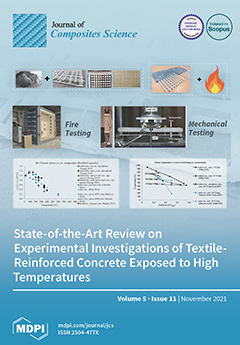Calcium carbonate (CaCO
3) particles have been widely used in filling thermoplastics for different applications in automotive, packaging, and construction. No agreement has been reached in the research community regarding the function of CaCO
3 for enhancing toughness of homopolymer polypropylene (HPP).
[...] Read more.
Calcium carbonate (CaCO
3) particles have been widely used in filling thermoplastics for different applications in automotive, packaging, and construction. No agreement has been reached in the research community regarding the function of CaCO
3 for enhancing toughness of homopolymer polypropylene (HPP). This study was to understand the effect of different loading levels of CaCO
3 on HPP toughness, including notched and unnotched impact strength. A batch mixer was used to thermally compound CaCO
3 particles with HPP at loading levels of 10, 20, 30, 40, and 50 wt.%, followed by specimen preparation using an injection molding process. The mechanical properties of the composites, including tensile, flexural, and impact were characterized. The results indicated that tensile strengths decreased significantly with increasing loading levels of CaCO
3 particles while the tensile and flexural modulus increased significantly with increasing particle loadings. The composite tensile properties changed linearly with increasing CaCO
3 loadings. The notched Izod impact strength of the composites was sustained by adding CaCO
3 particles up to 40 wt.% while the unnotched impact strength decreased significantly with the addition of CaCO
3 particles. Different deformation mechanisms between notched (fracture propagation) and unnotched (fracture initiation and propagation) impact tests were proposed to be the reason.
Full article





